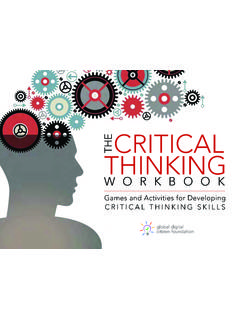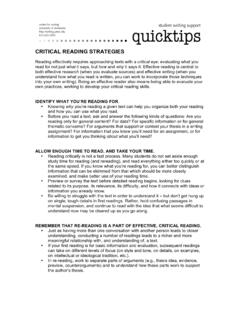Transcription of Critical thinking in Nursing: Decision-making and Problem …
1 Critical thinking in Nursing: Decision-making and Problem -solving Reviewed September 2017, Expires September 2019 Provider Information and Specifics available on our Website Unauthorized Distribution Prohibited 2017 , , , LLC By Wanda Lockwood, RN, BA, MA The purpose of this course is to explain processes of Decision-making and Problem -solving in relation to Critical thinking . Upon completion of this course, the healthcare provider should be able to: Define Critical thinking . Discuss Decision-making . Explain brainstorming techniques. Discuss different types of mapping. Discuss prioritizing. Explain multivoting and the prioritization matrix. Discuss 7 steps to Problem -solving. Introduction As medicine becomes more and more complex and nursing responsibilities increase, Critical thinking the ability to question and make rational decisions becomes even more important. Too often, healthcare providers simply follow routines and accept the word of authorities, such as administrators and physicians, without question, but Critical thinking requires that all thoughts and actions be examined objectively.
2 Additionally, in patient care, almost all actions require Decision-making and Problem -solving. Purpose Goals Critical thinkers must consistently apply intellectual standards [See CE course Critical thinking : Introduction]: clarity, accuracy, precision, relevance, depth, breadth, logic, significance, and fairness. Critical thinking is an essential element in Decision-making , which involves choices, and Problem -solving, which requires analysis. Decision-making A free flow of ideas is essential to Problem -solving and Decision-making because it helps prevent preconceived ideas from controlling the process. Many decisions in healthcare are arrived at by group or teams rather than by the individual, and this type of Decision-making requires special skills. General steps to all decision making include: Identifying a goal: What is the purpose of the decision? Establishing needs: Who will be affected? Identifying options: What choices are possible?
3 Making a plan: Which action should be taken? Taking action: Do it. Evaluating results: How did it work out? Effective group and individual Problem -solving begins with brainstorming, which can take many forms. Brainstorming should focus more on quantity of ideas than quality in the beginning. What are all the possibilities? People who are brainstorming individually may just think about possibilities, but writing the ideas down is sometimes more effective because it can be very difficult to remember all ideas. The simplest group approach is for people to just sit together and discuss ideas, but this can often lead to one or two people monopolizing the group or to circular or unfocussed discussions, so a more formal approach has benefits. During brainstorming, one person should serve as a facilitator, guiding the process. Brainstorming may be done in a structured manner or unstructured. In a structured approach, for example, each person may present an idea in turn while in an unstructured approach, people may speak at will.
4 Regardless of the method, some basic steps to brainstorming include: Establish and explain the purpose of the session. Establish a time frame. Decide whether to use a structured or unstructured approach. Decide on a format (lists, diagrams, etc.). List ideas in the chosen format. Discuss, clarify, and combine ideas. Brainstorming One popular method of brainstorming is the stickie approach in which group members individually write ideas on Post-its and then stick them on a bulletin board. (Alternately cards are used and placed on a table.) After this exercise, a facilitator or group members cluster those with similar topics. This method the creation of an affinity diagram helps to take many ideas and group them into headings and subheadings for discussion. This may work all right with a small group, but in a large group, the exercise often becomes chaotic and time-consuming. The group members have to go the bulletin board or table and try to read all the ideas, or someone has to read them out loud.
5 There is often much repetition and conflicting ideas or ideas (such as fire administrators or eliminate nurse aides ) that can lead to conflict or arguments. The basic anonymity of this format can lead people to make negative suggestions that they might not otherwise make. While this may be helpful at time, often it is not. The primary benefit of this approach is to the company that produces Post-its as those who have suffered through these sessions can generally attest. Decrease infectionsImprove handwashingPublish ward infection statisticsRemove Foleys in 24 hoursHire infection control professionalImprove housekeepingEmpty waste baskets q 4 hrsHire more housekeepersUse disposable mopsIncrease salaries of housekeepersIncrease nursing staffFire administratorsRaise salariesProvide tuition assistanceEliminate nurse aidesMapping Mapping often begins with a central Problem or issue, such as infection control, placed at the beginning point of a diagram.
6 As ideas for dealing with the Problem are suggested, they are added to the diagram. Any number of different types of diagrams can be used for mapping, such as the one below. For example, if one suggestion is to provide materials, then this suggestion would be further explored with suggestions, such as making posters to demonstrate correct infection control methods and providing informational brochures. During the brainstorming and mapping process, judgments about the value of the suggestions should be withheld until all ideas have been explored. If the discussion turns from exploring ideas to judging them, the facilitator needs to keep the group focused: Let s get all the ideas out first and then talk about them one by one. One useful method of brainstorming is to start with a desired outcome and work backward from that point, brainstorming what would lead to that outcome. Infection controlMaterialsPosterBrochureClassesOne -on-one demonstrationGroup Outcomes should be measurable and possible.
7 Starting with an unrealistic outcome like Eliminate all infections ensures failure as infections may result from endogenous as well as exogenous factors, and not every factor can be eliminated. A 50% reduction is more realistic for a first outcome. The Ishikawa fishbone diagram is used to brainstorm cause and effect, with the effect, in this case "High overall infection rate the head of the fish and the causes, the bones. Each bone or category is then questioned to determine what issues or problems are affecting that category. 50% reduction in infectionsHandwashing compliance Education Electronic reminderDecreased Foley catheter use Scheduled urination I&OChecklists Surgical Procedures The basic elements of brainstorming are the same regardless of the type of mapping used to help participants visualize relationships and remain focused. Open discussions that attempt to cover all and every topic, such as What does the institution need to do to improve quality of care?
8 Are much more difficult to manage than focused discussions and are often less effective, as suggestions may range far and wide with such disparate suggestions as increasing staff, emptying the waste baskets more frequently, providing better menu selections, painting the rooms a different color, and getting newer computer screens. These what-do-you-want-from-Santa Claus discussions can end up wasting a lot of time with little to show for it. The reality is that regardless of the value of multiple ideas, some prioritization is generally needed to determine the first action or the best alternative from a number of suggestions. This is an exercise in Decision-making . Numerous different methods can be used to prioritize. The simplist method for groups is just to vote, but if there are a number of different choices and a number of people voting, one-time voting may not always arrive at the best solution. For example, if there are three choices: A, B.
9 And C. and 15 people voting, the votes may be evenly split with 5 each. However, if A gets 6 votes, B gets 4, and C gets 5, A would win while in reality 9 people don t think that s the best choice. Inconsistent operative procedures Physician preference Lack of awarenessHigh rate of Foley catheter use Physician orders Lack of scheduled urinationPoor handwashing compliance inadequate training UnderstaffiingHigh overall infection ratePrioritizing Multivoting is one method to try to make voting more meaningful. In this case a voting method (check marks, red dots) is selected but with fewer votes available than items. For example, if there are 6 items to choose from, people may get 4 votes (one more than half the total number of items) and people can place all votes on one item or scatter the votes. The votes are tallied to determine which has the most votes. Then, a discussion is held, and usually those items that received no or few votes are eliminated, and then voting is done again, and so on until the top priority is selected, and a prioritized list is generated.
10 In some cases, after the initial vote, people may reconsider how they ve spread their votes and want to redo the initial vote. Another method is to create a prioritization matrix, usually with 4 categories as in the matrix below. Through discussion, each item is placed appropriately in the matrix. In general, those items that result in high benefit and low cost/effort are most desirable and head the list of priorities and those with low benefit and high cost/effort are least desirable. Problem -solving The same basic processes of Decision-making are used or should be by the individual healthcare provider on a daily basis when solving clinical problems even though the processes are less formal. High benefit, low cost/effort Ensure handwashing compliance Use surgical/procedure checklistsHigh benefit, high cost/effort Hire infection control specialistLow benefit, low cost/effort Produce postersLow benefit, high cost/effort Produce videos Send 4 administrators to National Infection Control conferenceReduce infections 50% Recognizing a Problem is of primary importance because if the Problem goes unrecognized, there is no attempt to find a solution.

















